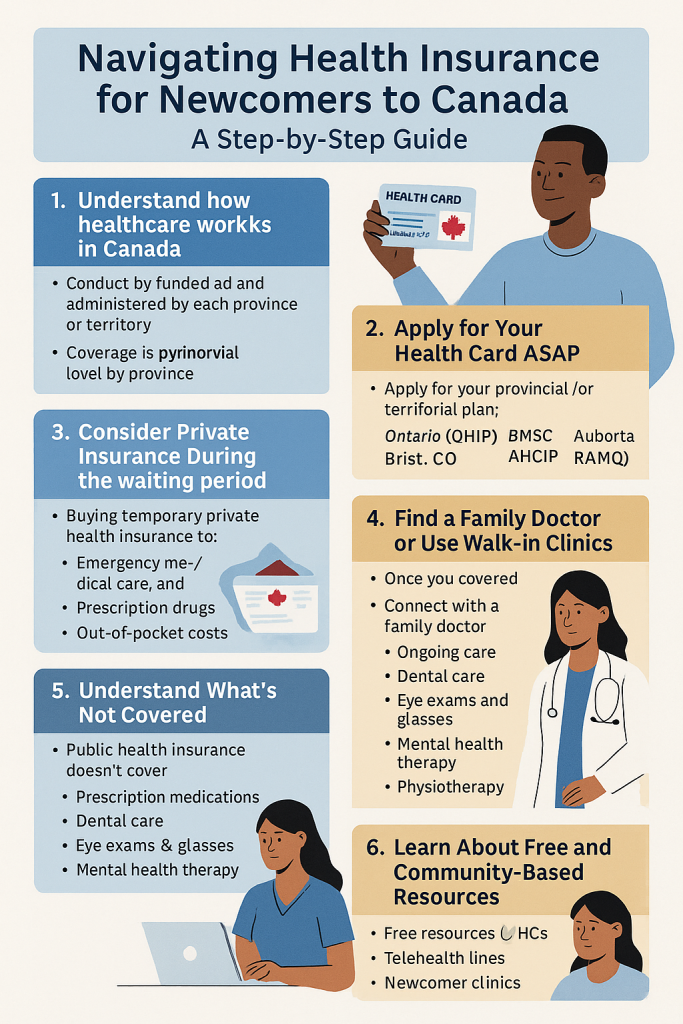If you’re new to Canada, you may be wondering how to get healthcare—and how much it’s going to cost. The good news is that Canada offers publicly funded health insurance to most residents, including newcomers. But the system varies by province, and there are important steps to take to ensure you’re covered from the start.
Here’s a simple, expert-guided breakdown to help you access the health services you’re entitled to in your new home.
Step 1: Understand How Healthcare Works in Canada
Canada’s healthcare is publicly funded and administered by each province or territory. That means:
- You need to register with your province’s health insurance plan
- Coverage includes hospital and doctor visits, tests, and more
- Each province may have different rules and waiting periods
This isn’t a one-size-fits-all system—so where you live matters.
Step 2: Apply for Your Health Card ASAP
Your health card is your key to accessing public healthcare. Once you arrive and establish residence, apply for your provincial or territorial plan:
- Ontario: OHIP (Ontario Health Insurance Plan)
- British Columbia: MSP (Medical Services Plan)
- Alberta: AHCIP (Alberta Health Care Insurance Plan)
- Quebec: RAMQ (Régie de l’assurance maladie du Québec)
Visit a Service Canada or provincial registration office with documents such as:
- Your permanent resident card or confirmation
- Proof of address
- Photo ID
Some provinces offer coverage immediately, while others (like BC or Ontario) may have a 3-month waiting period for newcomers.
Step 3: Consider Private Insurance During the Waiting Period
If your province has a waiting period before public coverage starts, consider buying temporary private health insurance. These plans can help cover:
- Emergency medical care
- Prescription drugs
- Ambulance services
- Out-of-pocket costs
Providers like Blue Cross, Manulife, and GMS offer newcomer-friendly plans.
Step 4: Find a Family Doctor or Use Walk-in Clinics
Once you’re covered, you’ll want to connect with a family doctor, who will:
- Provide ongoing care
- Refer you to specialists
- Help manage chronic conditions
Family doctors can be hard to find in some areas, but most provinces have online registries or waitlists to help match you.
Until then, you can visit walk-in clinics for minor illnesses and health concerns. These are usually covered by public health insurance once you’re enrolled.
Step 5: Understand What’s Not Covered
Public health insurance is comprehensive, but it doesn’t cover everything. You may need private or employer insurance for:
- Prescription medications
- Dental care
- Eye exams and glasses
- Mental health therapy
- Physiotherapy or chiropractic services
Check with your school (if you’re a student), employer, or local newcomer center to explore insurance options.
Step 6: Learn About Free and Community-Based Resources
Even if you don’t have full insurance yet, there are free services available in many communities:
- Community Health Centres (CHCs) for primary care and counseling
- Telehealth lines for advice from a nurse (e.g., 811 in BC, Ontario)
- Newcomer clinics or immigrant health programs with multilingual staff
These services are designed to help you stay healthy while navigating the system.
Final Thoughts: Settle in with Confidence
Adjusting to life in Canada takes time, but accessing healthcare doesn’t have to be confusing. By applying for your health card early, understanding what’s covered, and knowing where to go for care, you’ll be ready to take care of your health and your family’s from day one.
Because in Canada, health is a right—not a privilege.



